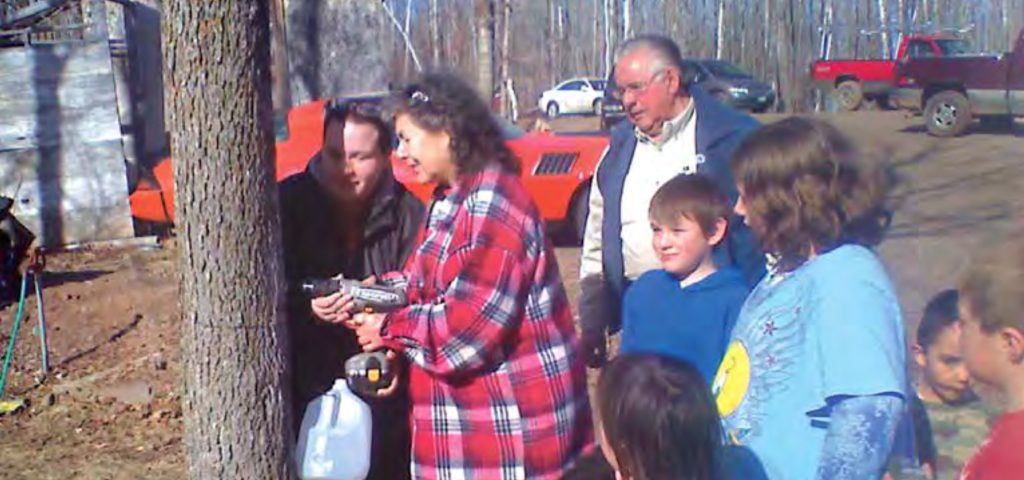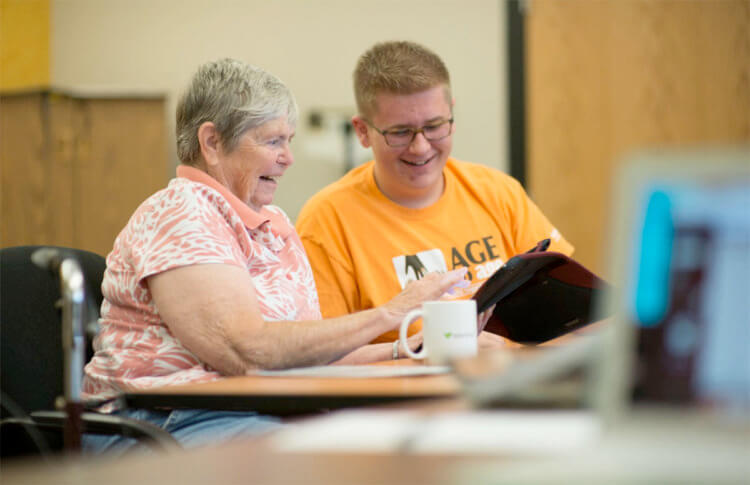by Beth Baker. This post originally appeared on Next Avenue.

Elders teaching Native American youth traditional sugarbushing to draw sap for maple syrup is one of the AGE to age program’s activities at the Fond du Lac Reservation.
Rick Ramey, 82, has always loved monarch butterflies. So when his community of Moose Lake, Minn., built a new public pavilion, he floated the idea of establishing butterfly gardens there.
“I thought this was an ideal spot, down by the river,” he said. The community embraced the idea, and before long Ramey was organizing children to plant marsh milkweed, a food source for monarchs. He now is invited to local schools to teach students about the butterfly life cycle.
Among those working alongside Ramey in planting the gardens was Sebastien Blondo, 11. “I’ve always loved butterflies and the monarch,” he said. He’s learned a lot volunteering with older adults in Moose Lake. “It’s fun to learn from their experiences and what they have to say about stuff.”
Bringing Generations Together
The pavilion and butterfly gardens are the result of an award-winning intergenerational program in rural Minnesota called AGE to age, created by the Duluth-based Northland Foundation.
Using a well-tested visioning process (a technique to help a group develop a shared vision of the future), each of 16 communities, including three American Indian reservations, has come up with its own field of dreams. All but one of the communities (Hibbing, with 25,000 people) are rural, ranging in population from 300 to 2,000. The voices of young and old are all at the table.
“In rural areas there are very limited resources and oftentimes very limited civic engagement opportunities,” said Lynn Haglin, vice president of the Northland Foundation and director of KIDS PLUS, its umbrella youth project that includes the intergenerational AGE to age. Many of the communities lack even a senior center. And young adults often move for better jobs, leaving grandparents far from their grandchildren.
“AGE to age is filling a great need, especially for older adults, as far as reducing isolation,” said Haglin. “They’re connecting with community and connecting with young people. Young people have a vibrancy that is definitely contagious and that helps older adults feel they have purpose and meaning in life.”
AGE to age was honored in 2012, 2015 and 2017 as a Program of Distinction by the nonprofit Generations United, and in 2017 Generations United gave Two Harbors Age to age its Best Intergenerational Community award.
Coming Up with an Intergenerational Idea
The community visioning process begins with a “speak out” where people representing every decade of the lifespan come together and answer questions designed to elicit the similarities and differences of their life experiences.
“Then we help them envision what they want the community to look like,” said Haglin. From there, they brainstorm ideas and eventually pare down their dream list to a set of priority projects that young and old implement together.
Fond du Lac Reservation AGE to age, for example, draws all ages to take part in traditional practices such as ricing, sugarbushing (tapping sugar maples for sap), and berry-picking. Elders pass on stories at monthly community dinners and an annual family camp has been revitalized and grown significantly.
Moose Lake AGE to age envisioned creating the public pavilion in an area that was an eyesore of dumped construction materials. The pavilion, eight years in the making, houses a lively farmers market, where Sebastien helps his mom sell lambs and wool. There are also regular crafts workshops, children’s activities and a popular intergenerational reading program.

Bob Libal helps Pat Hanson as part of the Two Harbors AGE to age Tech and Coffee program.
The Programs’ Many Benefits
The pavilion’s success spurred the city to revamp its hockey arena across the road.
“You build a pavilion, people use it,” said Ramey. The city added elevated fire pits, butterfly statues and benches. “It’s just a joy to see,” Ramey noted.
There’s even a modest economic boost, says Sebastien’s father, Steve Blondo. Tourists stop to buy produce, enjoy a picnic by the butterfly gardens and visit the town’s museum and brewery.
The small community has nurtured the Blondos’ relationships with people of all ages. “We have younger friends and older friends that are the age of my parents or even my grandparents. It’s about learning from the older and their experiences, as well as kind of forging ahead on our own,” said Steve Blondo.
For volunteer Rita Baresh, 77, AGE to age was a godsend following the sudden death of her husband in 2006. “I was scared out of my mind,” she said. She approached Vicki Radzak, who heads up AGE to age in Moose Lake, and said to her, “Keep me as busy as I can be.’”
Baresh became one of the program’s most active volunteers, recruiting many others to participate. While the pavilion was professionally built, Baresh said, “We had volunteers of all ages cleaning up the area and building the butterfly gardens. It’s been intergenerational all the way through.”
Baresh, who lives far from her children, discovered she has a knack for connecting with kids. She has had parents thank her for the relationship she forms with their children, even those whom the school finds difficult. “I haven’t had trouble with any of them, honest to God,” she said. “You have to find their passion, and you run with it.”
‘Tech and Coffee’
Seventy miles north, Two Harbors AGE to age created the popular Tech and Coffee, among many other projects. Instead of grousing about young people’s obsession with their cell phones, the community embraced the electronic expertise of teenagers. Through Tech and Coffee, high school students — over coffee — meet with older people who are having trouble using their phones or computers or mastering social media.
Organizing the program is AGE to age advisory board member Bob Libal, 17, who recruits his peers to volunteer.
“I feel like our society is built on the opinion that older individuals don’t approve of what younger people are doing, and that young people think [elders] don’t understand us,” he said. “But it’s so ridiculously backwards. The older generation are the perfect people to advise us. They’ve already gone through it.”
Bob enjoys the intergenerational give-and-take. He helped one older man upload images onto his computer. When the man, a retired high school teacher, found out Bob was struggling with his physics homework, he gave him a hand.
Another innovative Two Harbors project links generations through a new community radio station, KTWH-FM. “Because they had been involved in our visioning process, [KTWH founders] were very intentional in being intergenerational as part of their mission statement,” said Chris Langenbrunner, community education director for the school system, who leads Two Harbors AGE to age. Young people learn the ropes of broadcasting and interviewing and air oral histories of community elders.
Reconnecting to the Community
From the inception of Two Harbors AGE to age, Ed and Coral McMahon, both 76, have been among the top volunteers, contributing countless hours to a raft of projects, such as trail enhancement, a high school garden, a kids’ triathalon and bus trips with youngsters to Duluth to visit a museum and an aquarium.
After being gone from Two Harbors for 45 years, the McMahons returned there to Coral McMahon’s roots. AGE to age gave them a way to reconnect to the community. “We learned how to get along with kids,” said Coral McMahon. “We can’t be afraid of kids. We should be more open ourselves, and kids shouldn’t be afraid of us. We’re a small community. We should all get to know each other.”
Said Ed McMahon, with obvious delight: “There was one young girl, she called me Grandpa every time she saw me. It’s nice to see the kids listening to the adults and then sharing their ideas. That way you learn more what the children are all about and what they need.”
Beth Baker wrote this article for PBS Next Avenue as part of a series on innovative intergenerational programs, written with the support of a journalism fellowship from The Gerontological Society of America, New America Media and AARP. She is an author, most recently of the newly published With a Little Help from Our Friends—Creating Community as We Grow Older (Vanderbilt University Press, 2014).
The opinions expressed in this article are those of the author and do not necessarily reflect those of the Diverse Elders Coalition.

